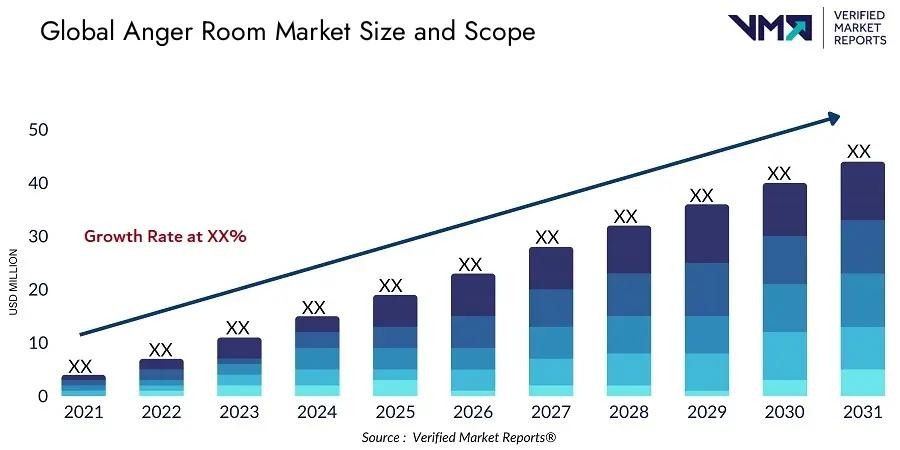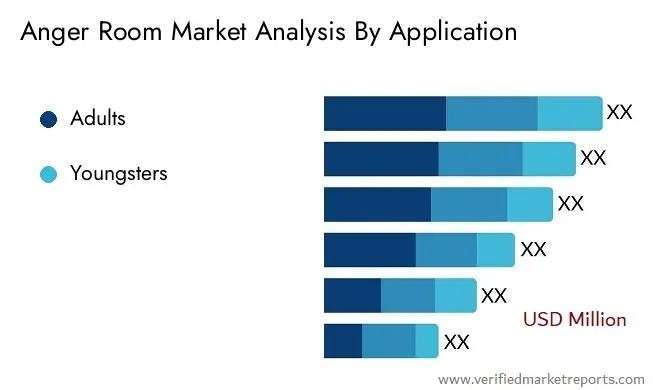Rage rooms, also known as smash rooms or anger rooms, have carved out a unique niche in both the entertainment and therapeutic markets. Originating as spaces where people could vent frustration by breaking objects, these establishments have become increasingly popular. In 2024, the concept of rage rooms is more relevant than ever, evolving with the stresses of modern life. This blog post aims to guide entrepreneurs interested in tapping into this burgeoning market, providing a comprehensive overview of how to start a rage room, delve into its history, understand the current market landscape, and explore the necessary steps to create a successful business.
Contents
History of Rage Rooms

The concept of a rage room first emerged in the early 2000s in Japan, a country known for its innovative approaches to stress management. The idea was simple yet powerful: provide a safe and controlled environment where individuals could release their anger by smashing objects without repercussions. This concept quickly caught on and spread globally.
By the mid-2010s, rage rooms had appeared in countries like the United States, Canada, and Russia, each adding their own cultural twists to the basic formula. The appeal was universal; these rooms offered a physical outlet for emotions in a society where expressing anger is often frowned upon. Over the years, rage rooms have evolved from underground activities to mainstream businesses, supported by both mental health advocates and those looking for unique entertainment options.
The Appeal of Rage Rooms
Rage rooms cater to a diverse clientele, each seeking relief from stress through the cathartic act of destruction. Psychologically, the act of breaking things can release endorphins, the body’s natural pain and stress relievers, which can create a feeling of euphoria akin to the “runner’s high” experienced after intense physical exercise. Socially, visiting a rage room can be a bonding activity, providing a unique way to spend time with friends, colleagues, or partners.
The benefits of rage rooms extend beyond immediate emotional relief; they provide a controlled environment where people can confront their emotions without judgment. This can be particularly appealing in today’s fast-paced world, where mental health awareness is on the rise, and people are continually looking for new ways to manage stress.
Current Rage Room Size & Market Overview
As of 2024, the rage room industry has witnessed a significant upsurge in popularity, translating into a robust growth in market value. Industry analysts estimate the global market cap for rage rooms to be approximately $200 million, with a projected annual growth rate of around 15% over the next five years. This growth is fueled by increasing awareness of mental health issues and the continuous search for alternative stress relief methods.

Top Countries with Thriving Rage Room Businesses:
- United States: Home to some of the first rage rooms outside Asia, the U.S. market is mature with facilities in most major cities. Innovations such as mobile rage rooms and themed events keep the market vibrant and growing.
- United Kingdom: The UK has seen a steady increase in the number of rage rooms, particularly in urban areas like London and Manchester, where high stress levels drive demand for such services.
- Canada: With a focus on mental wellness, Canadian entrepreneurs have successfully integrated rage rooms with other therapeutic services, making it a popular activity across age groups.
- Australia: In cities like Sydney and Melbourne, rage rooms not only cater to locals but also to tourists, making them a novel addition to the entertainment sector.
These countries represent the forefront of the rage room industry, each contributing to its global appeal through cultural adaptability and business innovation.
Starting a Rage Room in 2024
1) Market Research
The global market for rage rooms is currently estimated at around $450 million and is expected to grow by 30% by 2025. The United States leads with over 100 rage room businesses, followed by Canada and Australia, which are seeing an uptick in popularity due to rising stress levels and a growing focus on innovative mental health solutions.
2) Location and Logistics
Choosing the right location is crucial; areas with high foot traffic and easy accessibility from major entertainment or urban centers tend to perform best. The ideal facility size ranges from 1,500 to 3,000 square feet to accommodate different activity zones and ensure customer safety.
3) Legal Considerations
Operators must navigate various legal requirements, from obtaining special permits for handling hazardous materials (like broken glass) to ensuring compliance with local safety ordinances. Liability insurance costs can range from $3,000 to $5,000 annually, essential for covering potential injuries or accidents.
4) Investment and Costs
Initial investments can range between $10,000 and $50,000, depending on location, size, and the quality of destructible inventory and safety equipment. Key expenses include lease payments, purchasing initial inventory (electronics, furniture for smashing), and marketing to attract the first wave of customers.
5) Equipment and Setup Costs: Startup costs can vary widely depending on the location and scale. A basic setup includes procuring safety gear (helmets, gloves), breakable items (from thrift stores or donations), and creating a safe room environment that can withstand repeated abuse. Technology investments such as online booking systems can also enhance customer experience and operational efficiency.
6) Operations
Smooth operations are vital, with challenges including the regular procurement of smashable items and ensuring all safety measures are strictly followed. Employing staff who are trained in emergency response and customer interaction can enhance safety and customer satisfaction.
Marketing and Expansion Strategies For Newly started Rage Rooms
Effective marketing is key to attracting and retaining customers. Here are some strategies to consider:
Targeted Advertising: Utilize social media platforms to reach potential customers within your community. Targeted ads can help attract different demographic groups by highlighting the fun, stress-relief, or team-building aspects of rage rooms.
Community Events and Collaborations: Participating in local events or collaborating with mental health initiatives can raise awareness and demonstrate community involvement. Offering group packages can attract corporate teams and parties, increasing visibility and bookings.
Leveraging Reviews and Experiences: Encourage customers to share their experiences on social media and review platforms. Positive word-of-mouth and testimonials can be powerful tools for attracting new customers.
Statistical Insights
- Growth Trends: The industry’s annual growth rate is an impressive 25%, driven by increasing awareness of mental health and novel entertainment.

- Customer Demographics: Around 75% of customers are between the ages of 18 and 34, highlighting the appeal among younger, stress-prone adults.

Challenges and Considerations
Running a rage room involves logistical challenges such as sourcing a steady supply of items to be destroyed and managing the disposal of debris in an environmentally responsible manner. Misconceptions about promoting aggression also need to be addressed through positive messaging about the benefits of cathartic release.
Conclusion
Starting a rage room in 2024 represents a unique opportunity to tap into a growing market that caters to both entertainment and therapeutic needs. As we’ve explored, the success of such a venture hinges on understanding the history of rage rooms, recognizing their psychological and social benefits, and navigating the current market landscape effectively. The rise of rage rooms across top countries like the United States, United Kingdom, Canada, and Australia showcases the global appeal and potential profitability of this business.
For entrepreneurs ready to break into this industry, it is crucial to meticulously plan your business strategy, from selecting the right location and understanding legal requirements to implementing effective marketing strategies and exploring expansion opportunities. Safety and customer experience should remain at the forefront of your operational priorities, ensuring that your rage room not only meets but exceeds customer expectations.
FAQs: Statistical Insights on Starting a Rage Room
- What is the minimum budget required to start a rage room?
The minimum budget to start a rage room can vary based on location and scale but generally starts at around $10,000. This budget should cover basic lease costs, initial inventory of items to break, basic safety equipment, and minimal marketing to launch the business. - What is the current market size of the rage room industry?
As of 2024, the global market for rage rooms is estimated to be worth approximately $450 million. The market has been experiencing robust growth, with an anticipated annual increase of about 30% over the next few years due to rising awareness and popularity. - How much does it typically cost to invest in a rage room?
Initial investment costs for a rage room can range between $10,000 to $50,000. This includes expenses for leasing a space, purchasing safety equipment, acquiring breakables, and investing in marketing. High-end setups in prime locations with extensive marketing and larger inventory can exceed these estimates. - What are the average operational costs for running a rage room?
Operational costs can vary but typically include ongoing expenses such as rent, utilities, payroll for staff, continuous supply of breakables, and marketing activities. Monthly operational costs might range from $5,000 to $15,000 depending on the scale of the business. - What is the average profit margin for a rage room business?
Profit margins can vary widely, but rage room businesses can expect margins of around 40-60%. These margins depend heavily on location, effectiveness of marketing, cost management, and customer turnover rates. - What are the potential revenue streams for a rage room?
Beyond standard session fees, potential revenue streams include group bookings (e.g., corporate events, parties), merchandise sales (e.g., themed apparel, souvenirs), and special event nights. Offering membership packages or loyalty programs can also provide steady income. - How long does it take to break even with a rage room business?
The break-even point can vary based on initial investment, operational efficiency, and customer acquisition success. Typically, rage rooms may break even within the first 1 to 2 years of operation, depending on local market conditions and business management. - What factors influence the success of a rage room?
Key factors include strategic location, innovative and effective marketing, quality of customer experience, and efficient operational management. Keeping costs under control while offering an engaging and safe experience are crucial for long-term success.

Comments are closed